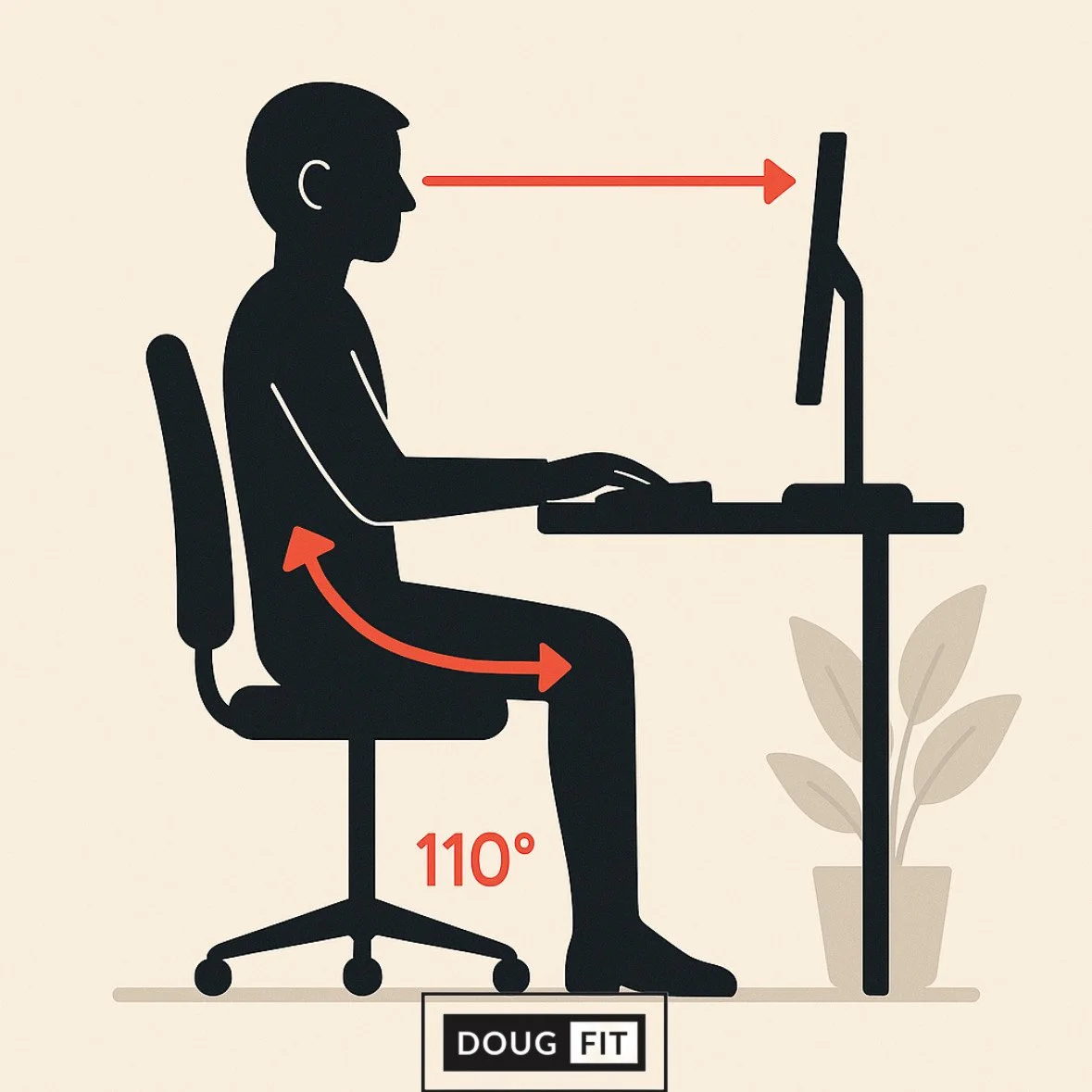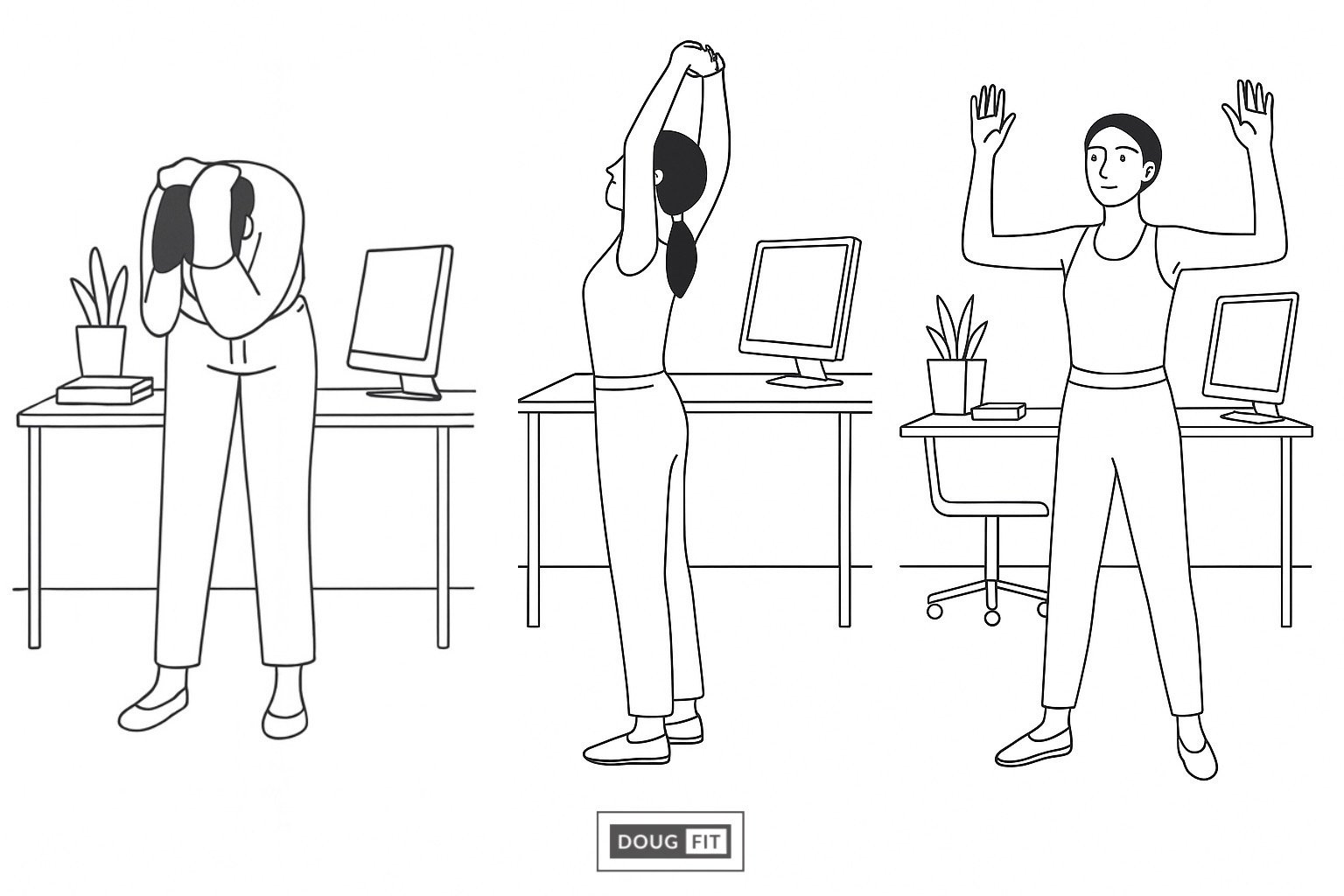How to improve posture at work: Fix your desk posture, ergonomics. Evidence based tips and stretches (Updated 2025 Guide)
Sitting at a desk all day can strain your neck and back. Learn simple posture tips and easy adjustments that improve comfort, boost energy and protect your long-term health at work.
Introduction
If you spend long hours at your desk or laptop, you’ve probably felt the toll it can take on your posture, neck, and lower back. Research shows that poor ergonomics not only cause daily discomfort but also increase the risk of chronic musculoskeletal issues.
The good news? With a few simple adjustments and stretches, you can dramatically improve your posture, reduce strain, and stay comfortable throughout the day.
Poor posture results from hunching over screen
Hunched posture at the desk puts extra stress on the neck and lower back—caused by forward head tilt and tight hip angles
In this evidence based article by Douglas Chironno M.S. RDN, Human Movement Specalist HMS; We will review
Common problematic posture habits from typical office set ups
Easy to apply evidence based sitting corrections that that can decrease strain on your neck and back
Simple and effective stretches you can do today to mitigate poor posture resulting from long hours of sitting
1. Common Posture Problems in Modern Workspaces
1a. Screen too low
When your monitor or laptop sits below eye level, your head naturally leans forward. This “tech neck” posture shortens the chest and shoulder muscles while straining the neck and upper back.
1a. Lap top screen to low, forcing head down and shoulders tipped foward
Every 15 degrees of head tilt dramatically increases pressure on the neck. Source: “Assessment of Stresses in the Cervical Spine Caused by Posture and Position of the Head” - Kenneth K. Hansaraj, Surgical Technology International, Volume 25 (2014) pp. 277-279.
1b. Foward lean in chair : Hips < 90 degrees
1b. Without proper back support, many workers sit in a hunched-forward position. This tightens the hip flexors and pulls the lower back into an unnatural curve, often leading to discomfort or pain in the lower back. - From my experience of initial interviews, this is the #1 complaint I hear from new lawyers and bankers.
2. Simple Ergonomic Fixes
Image of professional seated with open hips ( not in acute angle) and laptop lifted up by book or brief case to allow for less of a forward hunch and head tilt.
2a. Overview: Optimized Desk Position
2a. The big picture: Optimized Seated Posture with illustration of angles for upper and lower body
2 b. Optimized head position
2 b. Optimized head and neck position for computer work, screen at eye level
2 C. Optimized hip position
2 c. Optimized seated position , hips greater than 90 degrees flexion - Support your back and open your hips: If your chair doesn’t provide upright support or lift, try adding a small pillow or cushion. This prevents over tightening of your hip flexors and eases stress on the lower back.
3. Quick effective stretches you can do at the office
3 a. Standing Hip Flexor Stretch
3a. Toe Touch with Straight Back: Bend at the hips (not the lower back), keeping your spine straight. This hamstring stretch reduces tension in the back and legs.
3b. Standing Hip Flexor Stretch
3b. Hip Flexor Stretch: Step one foot forward into a lunge, keeping your torso upright. Gently rock forward to open the hip. For help getting into the stretch; you can raise and slightly bend your opposite arm for use as a counterweight.
3c. Chest Opener Stretch
3c. Chest Opener: Raise your arms overhead with palms forward, then lower your elbows to your sides. This stretches tight chest and shoulder muscles.
*Remember: Every body is different. Consult your healthcare provider before making changes if you have existing pain or injuries.
Want personalized posture and mobility coaching? Reach out at info@dougfit.com or explore more at DougFit.com.
References:
Hansraj, K. K. (2014). Assessment of stresses in the cervical spine caused by posture and position of the head. Surgical Technology International, 25, 277–279.
Bridger, R. S. (1988). Postural Adaptations to a Sloping Chair and Work Surface. Human Factors: The Journal of the Human Factors and Ergonomics Society, 30(2), 237-247. https://doi.org/10.1177/001872088803000210 (Original work published 1988)
Shirouchi, T., Murata, S., Horie, J., & Uchiyama, Y. (2022). Effect of different seat heights on lumbar spine flexion during sit-to-stand and stand-to-sit. Journal of Physical Therapy Science, 34(1), 44–49. <Effect of different seat heights on lumbar spine flexion during stand-to-sit motion - PMC>












